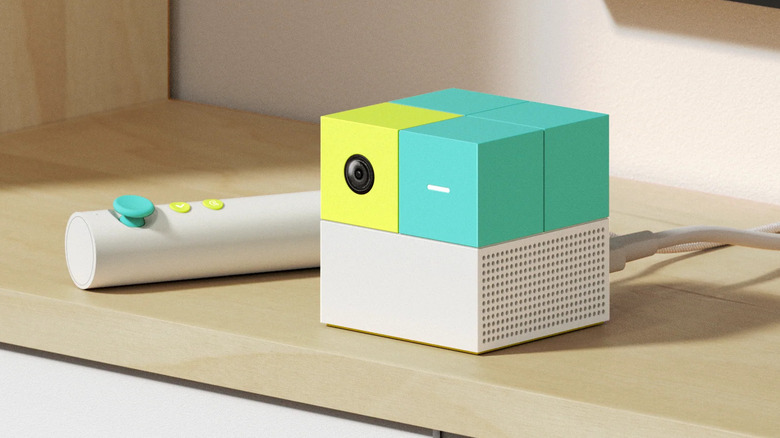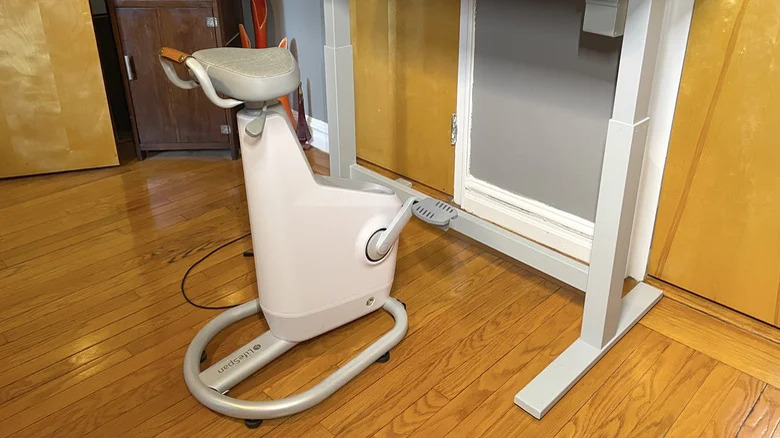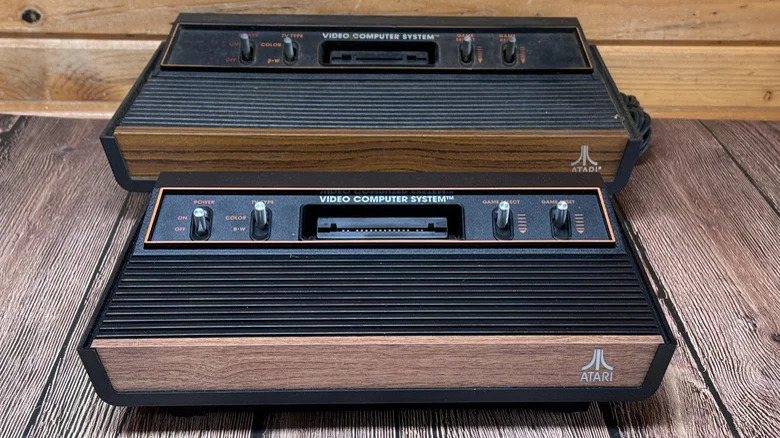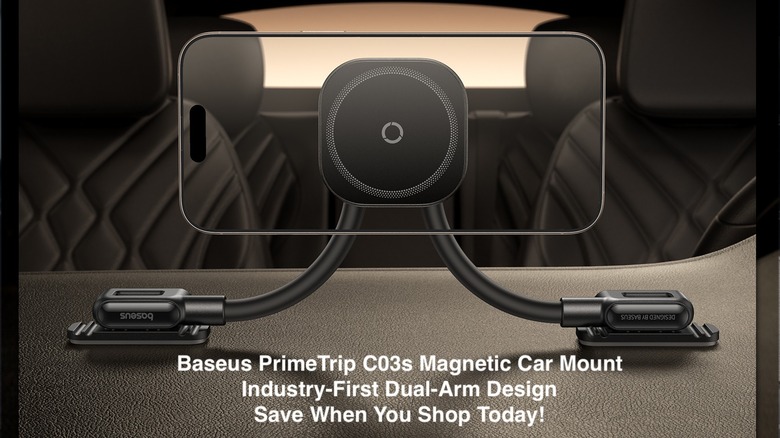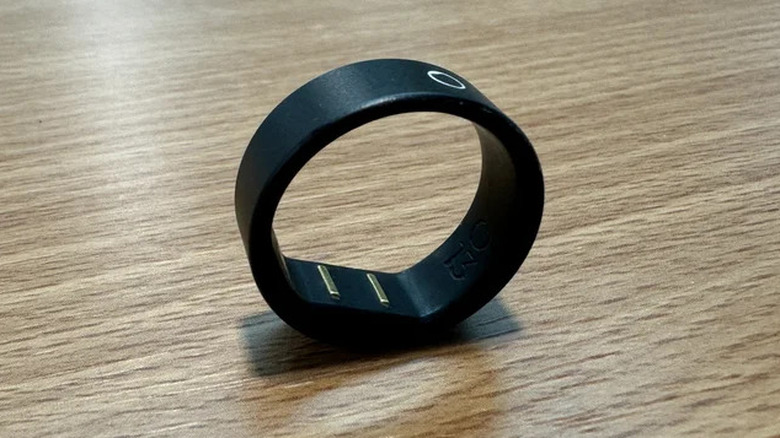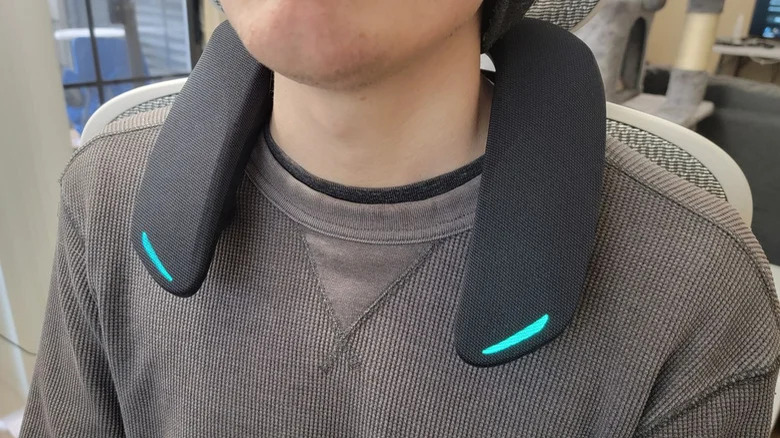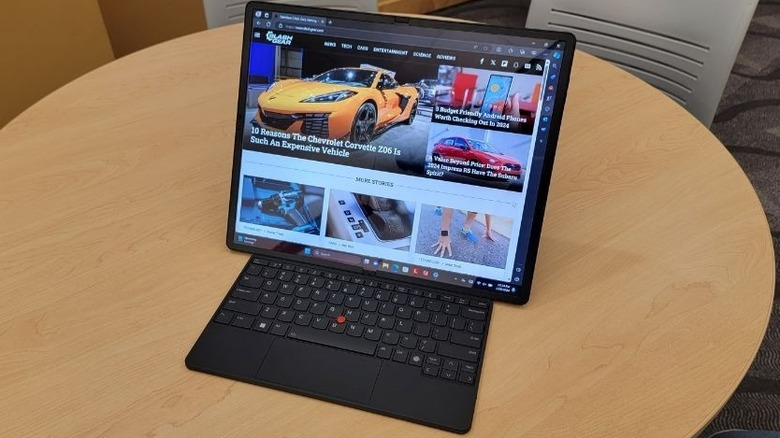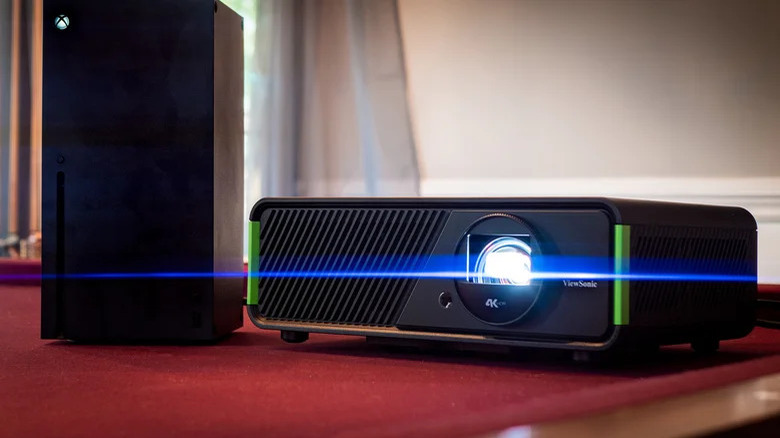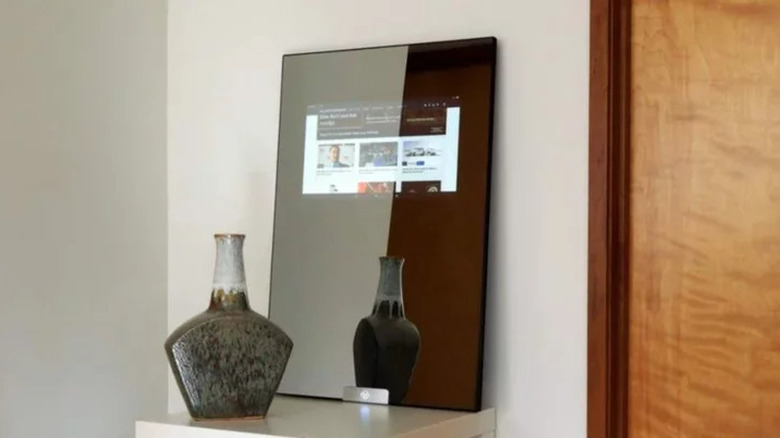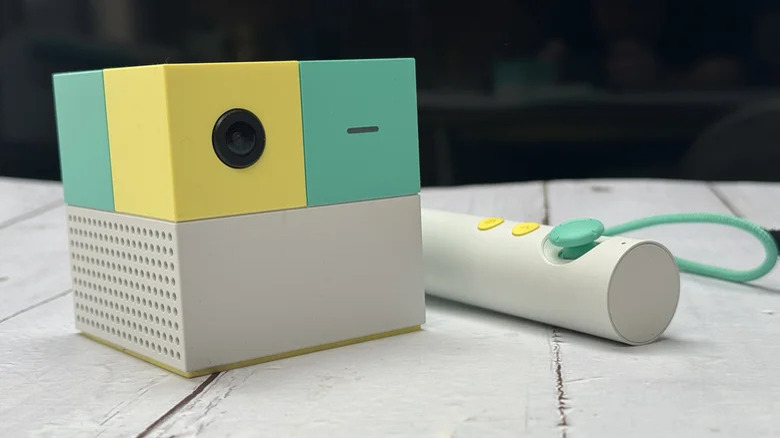12 Smart Gadgets You Didn't Know Existed
We may receive a commission on purchases made from links.
While it's easy to be amused by technology-averse family members complaining that smart tech "gets everywhere these days," there's more than a hint of truth to that statement. No longer is the smart home limited to voice assistants or color-changing light bulbs — now almost every household device can be made smarter to some degree. Whether that's always a good thing is debatable, but at the very least, a wider range of smart home tech gives buyers more options to choose from than ever.
With so many new gadgets hitting the market, it's easy to overlook a few of them. Even those who think they're in the know when it comes to cutting-edge tech might have missed a few of the latest releases, and for those who consider themselves "out of the loop," the huge array of tech out there can seem staggering. We've rounded up a selection of the most unusual tech that has made it into the hands of SlashGear's test team in recent years — some of which we were impressed by, and some of which we weren't.
LifeSpan Ampera office bike
Standing desks aim to solve the increasingly common problem of workers sitting still in the same position for too long, but they're not a perfect solution. While changing from a sitting to a standing position is beneficial compared to not moving at all, it's still not as beneficial as, say, getting a workout in while you sift through your emails. That's the premise of the LifeSpan Ampera office bike: provide the exercise benefits of a static bike without ever needing to leave your desk. Our review found that, in the most literal sense, it delivers on that promise. However, there are some caveats.
Its high seating position compared to a standard office chair means that it's impossible to fit under a fixed-height desk, so in order to use it, you'll need a standing desk. We also found the minimum seat height to be a problem — even at its lowest setting, our 5 feet, 4 inches tester found it very difficult to comfortably reach the pedals.
As well as functioning as an exercise outlet, the LifeSpan Ampera doubles up as a device charger, with one USB-C port and a Qi wireless charging pad for smartphones and other small devices. We found this feature worked as claimed, with a variety of gadgets able to be charged and around 1% charge achieved per five minutes of use. It's certainly a novel way to stay fit, but it's a costly one: the Ampera bike retails for $998.
Atari 2600 Plus retro gaming console
Gamers of a certain age will likely have fond memories of the original Atari 2600, but most probably won't be aware that Atari recently relaunched the console complete with a selection of original games. We reviewed the Atari 2600 Plus and found it to be, in many ways, a compelling recreation of the original.
Not only does it still look the same, but it also still features the same nine-pin connector for the controllers. That means anyone with old controllers lying around will be able to plug them straight into the new console. That comes in particularly handy since Atari only supplies one controller with the 2600 Plus, yet some of the games feature a two-player mode.
It's safe to say that this console is primarily targeted at buyers looking for a burst of nostalgia, and younger audiences more used to modern games likely won't find much to interest them other than the brief novelty value of playing something very old-school. However, with the Atari 2600 Plus retailing for $129.99, it's affordable enough to justify its limited appeal.
Circular Ring Slim fitness tracker
Not every new smart gadget lives up to the hype. The Circular Ring Slim promised a lightweight, slimmer alternative to the usual raft of health-tracking bands and smartwatches, but our testing found it to come with too many compromises to recommend. First, the good bits: the ring's battery lasted significantly longer than most smartwatches, and the health data it presented was easy to understand. It was, as promised, small and lightweight, to the point where our tester reported forgetting it was there at all. However, that was largely where the positives ended.
With such a limited surface to work with, the Ring Slim only has room for one touch-sensitive button. Our tester reported it being unnecessarily finicky to use, often resulting in the ring repeatedly triggering a morning alarm that, due to incorrectly registering button taps, had only been snoozed rather than turned off entirely. Durability was also a problem, and we noticed visible chips to the ring's black finish after a month of wear. Perhaps most disappointingly, though, some important health tracking features, such as the stress level monitor and medication reminders, are also partially hidden behind a paywall.
Given that the ring is expensive — retailing on Circular's website for $293, more than many good smartwatches — this seems like a counterintuitive move. The ring's primary function is to track health, and if buyers have to pay extra to get the ring's full monitoring package, they'd be better off sticking with a smartwatch.
Panasonic SoundSlayer Wireless wearable speaker
Long gaming stints using traditional room-filling speakers can cause anti-social levels of noise for other members in a household, but not everyone finds using gaming headphones comfortable. Panasonic's SoundSlayer Wireless finds a middle ground between the two, offering an alternative to bulky headsets with less noise pollution than regular speakers. Its unique wraparound design sees users place the device around their neck, with rubber grips on the underside to keep it in place.
Three preset modes are available to optimize sound for certain popular types of games, and there's also the option to create custom modes using the SoundSlayer PC app. Movie and music modes are also offered, although our tester felt these modes seemed like a bit of an afterthought — especially since the latter was noticeably lacking in overall quality compared to our benchmark Sony WH-1000XM4 headphones. It's also worth noting that there's no Bluetooth connectivity offered, which restricts the range of devices the SoundSlayer can be partnered with.
We found Panasonic's claimed 9-hour battery life to be roughly accurate, although we noted some inconsistencies in battery life estimates between the SoundSlayer PC app and the device itself. The built-in, AI-enhanced mic also impresses, successfully blocking out all game sounds even with the volume turned up. While it's far from perfect, the SoundSlayer speaker is a quirky alternative to gaming headphones — although, with a retail price of around $300, it's no small investment.
Lenovo ThinkPad X1 Fold 16 foldable laptop
Foldable smartphones like the Samsung Galaxy Z Fold line are gaining in popularity, but foldable laptops remain a rarity for now. The Lenovo ThinkPad X1 Fold 16 is one of the few examples currently on the market, and it's at least worth considering — if you can stomach its $3,599 asking price.
The X1 Fold can be arranged in several different layouts: it can be used as a tablet, complete with Lenovo's Precision Pen stylus for extra functionality, and it folds up to become a regular 12-inch laptop too. The keyboard can also be attached to the body of the laptop in either portrait or landscape orientation, which is where the X1 Fold really distinguishes itself from a regular 2-in-1 laptop.
The 16.3-inch OLED screen looks great when it's fully unfolded, both in terms of vibrancy and clarity, the latter thanks to its 2560 x 2024 resolution. It's durable too, with a magnesium and carbon fiber alloy frame and unique frame design that allows for maximum flexibility without compromising on strength. Where the ThinkPad X1 Fold starts to look less competitive, though, is its battery life. Our tester recorded a mere five hours of battery life between charges, significantly lower than Lenovo's official figures. That's disappointing for a laptop that costs more than $3,500, even if X1 Fold's versatility is impressive.
Nanoleaf 4D Screen Mirror and Lightstrip Kit
Nanoleaf's 4D Screen Mirror and Lightstrip Kit adds an extra layer of immersion to watching TV and movies by generating a glow that matches what's displayed on screen. The Screen Mirror kit consists of a camera that faces the display and the corresponding power unit, while the LED lightstrip can be affixed to the back of the TV unit. The kit is compatible with the Matter standard, so anyone already knee-deep in smart home tech should find it easy enough to integrate the lights with their existing setup.
Our reviewer was impressed with the range of colors and color combinations that could be achieved with the kit, especially when paired with a set of Nanoleaf's wall-mounted Shapes, which are sold separately. We noted a few issues with the initial setup, particularly in getting the devices connected to our WiFi network. One advertised feature, the room configurator to let the app know where the kit is within a room, also didn't work on our review unit. On the whole, however, we thought the $119.99 asking price for the Nanoleaf kit was reasonable given the drama it added to watching TV and movies.
ViewSonic X2-4K Xbox projector
Gaming monitors come with two inherent compromises: they're not designed to be portable, and buyers are limited in the range of sizes on offer. The ViewSonic X2-4K Xbox projector solves both of those issues, being just about small enough to fit in a backpack and offering display sizes up to 120 inches across. It's optimized specifically for the Xbox Series X, with support for a 120Hz refresh rate at 2560 x 1440 resolution. A 240Hz option for 1080p gaming is also offered for PC gamers.
Our reviewer noted the projector's consistently strong image quality, singling out the 40-degree alignment as a particular highlight. Even when aiming the projector at the wall at an unusually offset angle, the image still remained rectangular. The biggest downside to the X2-4K projector is its asking price: at an MSRP of $1,599, it's several times more expensive than the Series X itself, and there are a range of other decent projectors available for significantly less.
Invoxia Minitailz GPS pet tracker
Combining the functionality of a pet GPS tracker with the health monitoring of a fitness wearable, the Invoxia Minitailz GPS pet tracker is a new kind of smart gadget for your canine best friend. It delivers accurate, up to date GPS tracking to enable owners to see exactly where their pet is at all times, and will send an alert as soon as it detects a pet leaving a specified safe zone, like a house or yard.
Our reviewer couldn't fault its GPS tracking capabilities, although its health tracking was more of a mixed bag. While basics like heart rate monitoring and breathing rates seemed consistent, there were big inaccuracies in tracking different types of exercise. During the course of our testing, a car ride was mistakenly categorized as a walk, and jumping on the couch was mistakenly categorized as a car ride.
Our tester ended up disabling the activity tracker altogether, although Invoxia later released an update that remedied some of the faulty tracking. It might still be rough around the edges, but the Invoxia Minitailz has the potential to be a great tracker given its $99 starting price. Be aware, however, that like many similar trackers, the device will require an additional monthly subscription to function.
Adonit Star iPad stylus
Most tablet styluses tend to look roughly alike, but not the Adonit Star iPad stylus. It's shaped like a fountain pen, and much like its ink-filled counterpart, it's hardly cutting edge in the technology department. The Star is distinctly lacking in advanced stylus features, with only a single button and no pressure sensitivity or built-in shortcut support for creative apps. That's not necessarily a bad thing — this is, after all, a stylus for show more than for functionality — but it certainly limits its appeal. Artists and other creatives will want to look elsewhere.
Judging it purely as a creativity tool doesn't do it justice, however. This is primarily a novelty gadget for which its looks form the core of its appeal. In that regard, it does its job well: our tester thought the stylus felt premium and weighty in hand, albeit with the exception of the charging port cap, which broke during our test period.
The charging port in question is a USB-C port, although it won't need to be used too frequently thanks to the pen's claimed 11-hour battery life. That's a decent figure considering the Adonit Star costs $50, and it beats some more multifunctional rivals that cost significantly more. Whether that price is justified, however, will largely come down to how much value you place on the stylus' unique look and feel.
Capstone Connected Thin Cast Smart Mirror
A mirror with a built-in smart display throws up a few inevitable questions. Most will center around how well the screen's picture quality holds up given the reflective mirror glass, and how useful a screen that's built into something that most people only look at for a few moments a day really is. Unfortunately, the Capstone Connected Thin Cast doesn't really do much to convincingly answer those questions.
On the former point about picture quality, our reviewer found the image to be slightly underwhelming, struggling especially with brighter rooms. The latter point will come down more to personal preference, but unless you're the kind of person who spends a significant chunk of time looking at yourself in the mirror every day, it will probably be of limited use.
The mirror runs a modest Android setup, with very little storage and a chip that's typical of affordable tablets. Puzzlingly, there's no support for Google Play, so the range of apps available to load onto the mirror is extremely limited. A web browser, music player, and email app are among that range, but streaming apps and Google-branded apps are notably absent. There's also an option to mirror your phone to the display. The trouble is, the Connected Thin Cast retails for $799 from Capstone's website. That's far too much for what's essentially a cheap Android tablet inserted into a mirror, making it impossible to recommend despite its unique premise.
Whisker Feeder-Robot automatic pet feeder
Pet owners often find it difficult to fit feeding around their schedules, especially if they're away from home for most of the day. Gravity feeders have traditionally been the best solution, but Whisker's Feeder-Robot offers a smarter remedy. The feeder is programmable via an app or via the buttons on the device, and can dispense a precise portion of food at a preset time.
If a jam is detected or the food level becomes too low, the feeder will send its owner a notification via the app, with the latter also indicated by an LED light on the unit itself. The feeder is primarily designed for cats, but is also suitable for small dogs, and can hold up to 32 cups of kibble. For owners not content to rely on the feeder's smart features, there's also a backup gravity feeder mode available. There is a price to pay for this added tech, however: the Feeder-Robot's MSRP of $299.99 makes it significantly costlier than a traditional gravity feeder.
Nex Playground AR console
Microsoft's Kinect never quite hit the popularity levels its maker hoped it would, but the Nex Playground console bets that a new generation of children will be more excited by the "games as exercise" genre. Much like the Kinect, the Nex uses a camera to track a player's body movements, and translates them into various in-game responses. It's not fully gesture-controlled, however — there is still a separate controller required to navigate menus.
Almost every aspect of the console is explicitly geared towards kids, from the exterior design to the on-screen graphics and game selection. That's no bad thing, especially when the Nex Playground's $199 retail price puts it within birthday or Christmas present territory. But, unlike other family-oriented consoles, adults won't find as much to enjoy here, at least not once the novelty of the Playground's motion-tracking tech wears off. The console's VR-like appeal comes at a much more accessible price than, say, a Meta Quest, but there's a much smaller range of games on offer with the Nex for now. Plus, the $89 yearly subscription that's required to keep those games functional might put some buyers off.
Our selection methodology
SlashGear covers a vast array of tech, so to narrow down our selection to those items that most people wouldn't have heard of, we focused on gadgets that offered something unique to stand out from the crowd. Many of the above gadgets present an unusual spin on a well-known category of tech, or pack an extra set of features and functions in a segment that's usually quite uniform in what it offers buyers.
We also looked for gadgets in our review archive that provoked strong opinions from our reviewers — and not always positive ones — favoring those that we deemed too niche to appeal to a wider audience. Many of the gadgets here are also fairly new releases as of this writing, increasing the chance that they've flown under most enthusiasts' radars for now. Finally, we filtered out lesser-known products from the biggest tech brands, most of which are likely to have been seen by die-hard fans of the brand even if they didn't catch on with a wider audience.
